Assessing Ecosystem Services Supplied by Agroecosystems in Mediterranean Europe: A Literature Review
Abstract
1. Introduction
2. Materials and Methods
2.1. Literature Search
2.2. Selection Criteria
- (a)
- Assessed the link between biodiversity and the ecosystem service supplies or flows in Mediterranean agroecosystems;
- (b)
- Considered human or natural drivers impacting on Mediterranean agroecosystems and ecosystem services;
- (c)
- Considered trade-offs and synergies between agroecosystem services in the Mediterranean region;
- (d)
- Carried out a quantification of market and/or non-market values of agroecosystem services in the Mediterranean region;
- (e)
- Analysed agricultural policies and practices that enhance biodiversity and agroecosystem services in the Mediterranean region.
2.3. Data Extraction
- 1.1
- Year of publication;
- 1.2
- Country of affiliated institution of the first author;
- 1.3
- Paper perspective: productive, economic, social, conservation, mixed;
- 1.4
- Type of article: research or review;
- 1.5
- Type of analysis: quantitative, qualitative, conceptual;
- 1.6
- Study location: Mediterranean Basin, European Mediterranean, northwest Mediterranean, northeast Mediterranean, Northern Africa;
- 1.7
- Scale of the study: Mediterranean Basin, European Mediterranean region, northern western Mediterranean, northern eastern Mediterranean, national, local;
- 2.1
- TEEB ecosystem service category: provisioning, regulating, habitat or supporting, cultural services;
- 2.2
- TEEB ecosystem services considered: crop provisioning, pollination, soil fertility, nutrient cycling, habitat for species, carbon sequestration, pest control, food production, soil erosion, freshwater, raw material, tourism and recreation, cultural value, various (>4 ecosystem services);
- 2.3
- Ecosystem services cascade model stage considered: biophysical structure, ecosystem function, ecosystem service, benefits, socio-cultural and economic value;
- 2.4
- Drivers and pressures on agroecosystems and ecosystem services;
- 2.5
- Synergies between agroecosystem services;
- 2.6
- Type of agroecosystem: arable, agroforestry, multi-crop, grassland;
- 2.7
- Type of crop: e.g., wheat, vineyard, olive, rice;
- 2.8
- Type of cultivation system: homogenous, heterogeneous;
- 2.9
- Involvement of stakeholder groups: farmers, agronomists and other experts, residents, tourists, researchers.
2.4. Data Analysis
3. Results and Discussion
3.1. Overview of the Selected Papers
3.2. Ecosystem Services
3.3. Drivers and Pressures Acting on Mediterranean Agroecosystems
3.4. Ecosystem Service Synergies
3.5. Gaps and Recommendations for Future Research
4. Conclusions
Author Contributions
Funding
Acknowledgments
Conflicts of Interest
Appendix A
| Authors | Title | Year | Journal | |
|---|---|---|---|---|
| 1. | D. Hermans | The encounter of agriculture and tourism a catalan case | 1981 | Annals of Tourism Research |
| 2. | A. Gerakis, K. Kalburtji | Agricultural activities affecting the functions and values of Ramsar wetland sites of Greece | 1998 | Agriculture, Ecosystems and Environment |
| 3. | S.G. Potts, T. Petanidou, S. Roberts, C. O’Toole, A. Hulbert, P. Willmer | Plant-pollinator biodiversity and pollination services in a complex Mediterranean landscape | 2006 | Biological Conservation |
| 4. | J.H.N. Palma, A.R. Graves, R.G.H. Bunce, P.J. Burgess, R. de Filippi, K.J. Keesman, H. van Keulen, F. Liagre, M. Mayus, G. Moreno, Y. Reisner, F. Herzog | Modeling environmental benefits of silvoarable agroforestry in Europe | 2007 | Agriculture, Ecosystems and Environment |
| 5. | A. Bernués, R. Ruiz, A. Olaizola, D. Villalba, I. Casasús | Sustainability of pasture-based livestock farming systems in the European Mediterranean context: Synergies and trade-offs | 2011 | Livestock Science |
| 6. | F.J. González-Estébanez, S. García-Tejero, P. Mateo-Tomás, P.P. Olea | Effects of irrigation and landscape heterogeneity on butterfly diversity in Mediterranean farmlands | 2011 | Agriculture, Ecosystems and Environment |
| 7. | B.A. Willaarts, M. Volk, P. A. Aguilera | Assessing the ecosystem services supplied by freshwater flows in Mediterranean agroecosystems | 2012 | Agricultural Water Management |
| 8. | M. Nieto-Romero, E. Oteros-Rozas, J.A. Gonzalez, B. Martin-Lopez | Exploring the knowledge landscape of ecosystem services assessments in Mediterranean agroecosystems: Insights for future research | 2014 | Environmental Science & Policy |
| 9. | I. Guerrero, C.P. Carmona, M.B. Morales, J.J. Oñate, B. Peco | Non-linear responses of functional diversity and redundancy to agricultural intensification at the field scale in Mediterranean arable plant communities | 2014 | Agriculture, Ecosystems and Environment |
| 10. | I. Rossetti, S. Bagella, C. Cappai, M.C. Caria, R. Lai, P.P. Roggero, P. Martins da Silva, J.P. Sousa, P. Querner, G. Seddaiu | Isolated cork oak trees affect soil properties and biodiversity in a Mediterranean wooded grassland | 2015 | Agriculture, Ecosystems and Environment |
| 11. | A. La Notte, C. Liquete, B. Grizzetti, J. Maes, B.N. Egoh, M.L. Paracchini | An ecological-economic approach to the valuation of ecosystem services to support biodiversity policy. A case study for nitrogen retention by Mediterranean rivers and lakes | 2015 | Ecological Indicators |
| 12. | J.G. Navedo, S. Hahn, M. Parejo, J.M. Abad-Gómez, J.S. Gutiérrez, A. Villegas, J.M. Sánchez-Guzmán, J.A. Masero | Unravelling trophic subsidies of agroecosystems for biodiversity conservation: Food consumption and nutrient recycling by waterbirds in Mediterranean rice fields | 2015 | Science of the Total Environment |
| 13. | X. Puig-Montserrat, I. Torre, A. López-Baucells, E. Guerrieri, M.M. Monti, R. Ràfols-García, X. Ferrer, D. Gisbert, C. Flaquer | Pest control service provided by bats in Mediterranean rice paddies: linking agroecosystems structure to ecological functions | 2015 | Mammalian Biology |
| 14. | A. De Frutos, P.P. Olea, P. Mateo-Tomás | Responses of medium- and large-sized bird diversity to irrigation in dry cereal agroecosystems across spatial scales | 2015 | Agriculture, Ecosystems and Environment |
| 15. | M. Cohen, C. Bilodeau, F. Alexandre, M. Godron, J. Andrieu, E. Grésillon, F. Garlatti, A. Morganti | What is the plant biodiversity in a cultural landscape? A comparative, multi-scale and interdisciplinary study in olive groves and vineyards (Mediterranean France) | 2015 | Agriculture, Ecosystems and Environment |
| 16. | T. Rodríguez-Ortega, A. Bernués, F. Alfnes | Psychographic profile affects willingness to pay for ecosystem services provided by Mediterranean high nature value farmland | 2016 | Ecological Economics |
| 17. | R.E. Creamer, S.E. Hannula, J.P. Van Leeuwen, D. Stone, M. Rutgers, R.M. Schmelz, P.C. de Ruiter, N. Bohse Hendriksen, T. Bolger, M.L. Bouffaud, M. Buee, F. Carvalho, D. Costa, T. Dirilgen, R. Francisco, B.S. Griffiths, R. Griffiths, F. Martin, P. Martins da Silva, S. Mendes, P.V. Morais, C. Pereira, L. Philippot, P. Plassart, D. Redecker, J. Römbke, J.P. Sousa, M. Wouterse, P. Lemanceau | Ecological network analysis reveals the inter-connection between soil biodiversity and ecosystem function as affected by land use across Europe | 2016 | Applied Soil Ecology |
| 18. | T. Dirilgen, J. Arroyo, W.J. Dimmers, J. Faber, D. Stone, P. Martins da Silva, F. Carvalho, R. Schmelz, B.S. Griffiths, R. Francisco, R.E. Creamer, J.-P. Sousa, T. Bolger | Mite community composition across a European transect and its relationships to variation in other components of soil biodiversity | 2016 | Applied Soil Ecology |
| 19. | B.S. Griffiths, J. Römbke, R.M. Schmelz, A. Scheffczyk, J.H. Faber, J. Bloem, G. Pérès, D. Cluzeau, A. Chabbi, M. Suhadolc, J.P. Sousa, P. Martins da Silva, F. Carvalho, S. Mendes, P. Moraish, R. Francisco, C. Pereira, M. Bonkowski, S. Geisen, R.D. Bardgett, F.T. de Vries, T. Bolger, T. Dirilgen, O. Schmidtl, A. Winding, N.B. Hendriksen, A. Johansen, L. Philippot, P. Plassart, D. Bru, B. Thomson, R.I. Griffiths, M.J. Bailey, A. Keith, M. Rutgers, C. Mulder, S.E. Hannula, R. Creamer, D. Stone | Selecting cost effective and policy-relevant biological indicators for European monitoring of soil biodiversity and ecosystem function | 2016 | Ecological Indicators |
| 20. | A.M. Santana-Corderoa, E. Ariza, F. Romagosa | Studying the historical evolution of ecosystem services to inform management policies for developed shorelines | 2016 | Environmental Science & Policy |
| 21. | E. Soy-Massoni, J. Langemeyer, D. Varga, M. Sáez, J. Pintó | The importance of ecosystem services in coastal agricultural landscapes: Case study from the Costa Brava, Catalonia, Ecosystem Services | 2016 | Ecosystem Services |
| 22. | M. Torralba, N. Fagerholm, P.J. Burgess, G. Moreno, T. Plieninger | Do European agroforestry systems enhance biodiversity and ecosystem services? A meta-analysis | 2016 | Agriculture, Ecosystems and Environment |
| 23. | N. Fagerholm, M. Torralba, P.J. Burgess, T. Plieninger | A systematic map of ecosystem services assessments around European agroforestry | 2016 | Ecological Indicators |
| 24. | A. Lopez-Sanchez, A. San Miguel, C. Lopez-Carrasco, L. Huntsinger, S. Roig | The important role of scattered trees on the herbaceous diversity of a grazed Mediterranean dehesa | 2016 | Acta Oecologica |
| 25. | C. Salomé, P. Colla, E. Lardo, A. Metay, C. Villenave, C. Marsden, E. Blanchart, P. Hinsinger, E. Le Cadre | The soil quality concept as a framework to assess management practices in vulnerable agroecosystems: A case study in Mediterranean vineyards | 2016 | Ecological Indicators |
| 26. | A. Bernuésa, E. Tello-García, T. Rodríguez-Ortega, R. Ripoll-Bosch, I. Casasús | Agricultural practices, ecosystem services and sustainability in High Nature Value farmland: Unraveling the perceptions of farmers and nonfarmers | 2016 | Land Use Policy |
| 27. | F. Trolard, G. Bourrie, A. Baillieux, S. Buis, A. Chanzy, P. Clastre, J.F. Closet, D. Courault, M.L. Dangeard, N. Di Virgilio, P. Dussouilliez, J. Fleury, J. Gasc, G. Geniaux, R. Jouan, C. Keller, P. Lecharpentier, J. Lecroart, C. Napoleone, G. Mohammed, A. Olioso, S. Reynders, F. Rossi, M. Tennant, J. de Vicente Lopez | The PRECOS framework: Measuring the impacts of the global changes on soils, water, agriculture on territories to better anticipate the future | 2016 | Journal of Environmental Management |
| 28. | V. Gkisakis, N. Volakakis, D. Kollaros, P. Bàrberi, E. M. Kabourakis | Soil arthropod community in the olive agroecosystem: Determined by environment and farming practices in different management systems and agroecological zones | 2016 | Agriculture, Ecosystems and Environment |
| 29. | H. Castro, L. Barrico, S. Rodríguez-Echeverría, H. Freitas | Trends in plant and soil microbial diversity associated with Mediterranean extensive cereal-fallow rotation agro-ecosystems | 2016 | Agriculture, Ecosystems and Environment |
| 30. | X.O. Solé-Senana, A. Juárez-Escario, I. Robleño, J.A. Conesa, J. Recasens | Using the response-effect trait framework to disentangle the effects of agricultural intensification on the provision of ecosystem services by Mediterranean arable plants | 2017 | Agriculture, Ecosystems and Environment |
| 31. | M. Brambilla, L. Ilahiane, G. Assandri, S. Ronchi, G. Bogliani | Combining habitat requirements of endemic bird species and other ecosystem services may synergistically enhance conservation efforts | 2017 | Science of the Total Environment |
| 32. | G. Montanaro, C. Xiloyannis, V. Nuzzo, B. Dichio | Orchard management, soil organic carbon and ecosystem services in Mediterranean fruit tree crops | 2017 | Scientia Horticulturae |
| 33. | A. Juárez-Escario, J.A. Conesa, X.O. Solé-Senan | Management as a driver of functional patterns and alien species prominence in weed communities of irrigated orchards in Mediterranean areas | 2017 | Agriculture, Ecosystems and Environment |
| 34. | I.P. Holman, C. Brown, V. Janes, D. Sandars | Can we be certain about future land use change in Europe? A multi-scenario, integrated-assessment analysis | 2017 | Agricultural Systems |
| 35. | M. Lazzaro, A. Costanzo, P. Bàrberi | Single vs multiple agroecosystem services provided by common wheat cultivar mixtures: Weed suppression, grain yield and quality | 2017 | Field Crops Research |
| 36. | M.V. Balzan, J. Caruana, A. Zammit | Assessing the capacity and flow of ecosystem services in multifunctional landscapes: Evidence of a rural-urban gradient in a Mediterranean small island state | 2018 | Land Use Policy |
| 37. | D. Surová, F. Ravera, N. Guiomar, R. Martínez Sastre, T. Pinto-Correia | Contributions of Iberian Silvo-Pastoral Landscapes to the Well-Being of Contemporary Society | 2018 | Rangeland Ecology & Management |
| 38. | G. Assandri, G. Bogliani, P. Pedrini, M. Brambilla | Beautiful agricultural landscapes promote cultural ecosystem services and biodiversity conservation | 2018 | Agriculture, Ecosystems and Environment |
| 39. | M. Emmerson, M.B. Morales, J.J. Oñate, P. Batáry, F. Berendse, J. Liira, T. Aavik, I. Guerrero, R. Bommarco, S. Eggers, T. Part, T. Tscharntke, W. Weisser, L. Clement, J. Bengtsson | Chapter Two: How Agricultural Intensification Affects Biodiversity and Ecosystem Services | 2018 | Advances in Ecological Research |
| 40. | L. Schaller, S. Targettib, A.J. Villanueva, I. Zasada, J. Kantelhardt, M. Arriaza, T. Bal, V. Bossi Fedrigotti, F.H. Giray, K. Häfner, E. Majewski, A. Malak-Rawlikowska, D. Nikolov, J.C. Paoli, A. Piorr, M. Rodríguez-Entrena, F. Ungaro, P.H. Verburg, B. van Zanten, D. Viaggi | Agricultural landscapes, ecosystem services and regional competitiveness - Assessing drivers and mechanisms in nine European case study areas | 2018 | Land Use Policy |
| 41. | M. Mendoza-García, J.M. Blanco-Moreno, L. Chamorro, L. José-María, F.X. Sans | Patterns of flower visitor abundance and fruit set in a highly intensified cereal cropping system in a Mediterranean landscape | 2018 | Agriculture, Ecosystems and Environment |
Appendix B
| Ecosystem Service | Capacity | Flow | Benefit |
|---|---|---|---|
| Food Production | Wheat production yield (t/ha) [45] | Food production [31] | Willingness-to-pay of local residents and tourist [24] |
| Number of spikes (per m2) [45] | Downscaled crop production (t/km2) [13] | ||
| Number of seeds per spike [45] | Number of hives (per km2) [13] | ||
| Beekeepers’ habitat preference (Frequency of responses) [13] | |||
| kernel weight (g) [45] | |||
| Number of quality products available for consumers [46] | |||
| Raw Material | Rainfed agricultural land (Fodder production potential) [13] | Livestock (number of Cattle, Sheep, Goats and Pigs)/km2 [13] | |
| Land occupation [39] | |||
| Fresh Water | Soil hydraulic conductivity (mm/h) [23] | Water infiltration [47] | |
| Soil macroporosity (%) [23] | Drinking water supply [39] | ||
| Risk of water salinity [39] | |||
| Wastewater Treatment | NO2 deposition velocity (mm/s) [13] | NO2 removal flux (t/ha/year) [13] | Willingness-to-pay of local residents and tourist [24] |
| Pollination | Functional diversity of arable plant communities (Rao’s quadratic entropy) [48] | Pollen grain deposition (species/site) [42] | Willingness-to-pay of local residents and tourist [24] |
| Weed species abundance (%) [41] | Crop pollinator dependency [13] | ||
| Butterfly species richness | |||
| Butterfly species abundance | |||
| Wheat flowering onset [32] | |||
| Pollinator visitation probability [13] | |||
| Richness and abundance of wildplants [49] | |||
| Bees abundance [49] | |||
| Non-bee flower visitor abundance [49] | |||
| Erosion Prevention and Maintenance of Soil Fertility | Microbial diversity [50] | Microbial function (nitrification, extracellular enzymes, multiple substrate induced respiration) [50] | |
| Microfauna diversity (nematode trophic group) [50] | Nitrogen and Phosphorous recycling by waterbird species in rice fields [51] | ||
| Fauna abundance (%) [47] | N leaching (kg/ha/year) [52] | ||
| Mesofauna diversity (enchytraeids and Collembola species) [50] | Nitrification [47] | ||
| Soil runoff yield (mm), soil loss (mg/ha), sediment (kg/m3) [23] | Mineralisable Nitrogen [47] | ||
| Earthworms abundance (%) [23] | Microbial respiration [47] | ||
| Plant species richness (Shannon index) [53] | |||
| Collembola species richness (Shannon index) [53] | |||
| Floor litter dry matter (t/ha) [53] | |||
| Waterbird abundance [51] | |||
| Diet composition of waterbirds foraging in rice fields [51] | |||
| Food consumption from waterbirds (kJ/bird/day) in rice fields [51] | |||
| Microbial abundance (%) [47] | |||
| Soil physical indicators [34] | |||
| Soil chemical indicators [34] | |||
| Soil biological indicators [34] | |||
| Nematode ecological indicators [34] | |||
| Plant species richness [33] | |||
| Bacteria species richness [33] | |||
| Fungi species richness [33] | |||
| Mite species classification and quantification [54] | |||
| Molecular microbial biomass [54] | |||
| Soil erosion (t/ha/year) [52] | |||
| Plant species richness (Shannon index) [30] | |||
| Soil loss (t/ha/year) [35] | |||
| Soil agronomic qualification index [39] | |||
| Risk of soil salinization [39] | |||
| Habitat for Species | Functional dominance of Mediterranean arable plants (Community weighted mean) [48] | Willingness-to-pay of local residents and tourist [24] | |
| Abundance and occurrence of a bird species [35] | Cattle beef variable costs, subsidies (€/cow) [37] | ||
| Weed species traits (%) [41] | Gross Margin of beef cattle (€/cow) [37] | ||
| Floristic composition of herbal layer [30] | Sheep meat variable costs, subsidies (€/ewe) [37] | ||
| Number of cattle and sheep holdings [37] | Gross Margin of sheep meat (€/ewe) [37] | ||
| Number of cattle and sheep heads [37] | |||
| Drainage in wetland [39] | |||
| Carbon Sequestration and Storage | Soil organic carbon (%) [23] | Willingness-to-pay of local residents and tourist [24] | |
| Carbon sequestration (t/ha) [52] | |||
| Habitat index (%) [52] | |||
| Pest Control | Soil arthropod abundance [55] | ||
| Soil arthropod functional diversity [55] | |||
| Bat passes (per minute) [56] | |||
| DNA Extraction and sequencing of rice borer (pest) from bat droppings [56] | |||
| Bat dropping collection [56] | |||
| Morphological analysis of insect fragments from bat droppings [56] | |||
| Bird species richness [36] | |||
| Bird species abundance [36] | |||
| Weed biomass (g/m2) [45] | |||
| Wheat leaf area (mm2/mg) [32] | |||
| Wheat mean Canopy height (cm) [32] | |||
| Wheat seed mass (mg) [32] | |||
| Maintenance of Genetic Diversity | Population of bearded vultures [46] | ||
| Local Climate and Air Quality | Climate regulation [31] | ||
| Moderation of Extreme Events | Number of fire events [46] | ||
| Aesthetic Appreciation and Culture | Number of habitats of community importance [13] | Preference Assessment with locals (Frequency of responses) [13] | Willingness-to-pay of local residents and tourist [24] |
| Floral richness [27] | |||
| Floral biological trait index [27] | |||
| Plot edge diversity [27] | |||
| Steinhaus index [27] | |||
| Plot spatial diversity [27] | |||
| Bird species richness [26] | |||
| Land-cover/topographic variables [26] | |||
| Vineyard management [26] | |||
| Shannon land-cover diversity index [26] | |||
| Visual representation of agricultural landscape [46] |
References
- Blondel, J. The ‘Design’ of Mediterranean Landscapes: A Millennial Story of Humans and Ecological Systems during the Historic Period. Hum. Ecol. 2006, 34, 713–729. [Google Scholar] [CrossRef]
- Myers, N.; Mittermeier, R.A.; Mittermeier, C.G.; da Fonseca, G.A.B.; Kent, J. Biodiversity hotspots for conservation priorities. Nature 2000, 43, 853–858. [Google Scholar] [CrossRef]
- Balzan, M.V.; Pinheiro, A.M.; Mascarenhas, A.; Morán-Ordóñez, A.; Ruiz-Frau, A.; Carvalho-Santos, C.; Vogiatzakis, I.; Arends, J.; Santana-Garcon, J.; Roces-Díaz, J.V.; et al. Improving ecosystem assessments in Mediterranean social-ecological systems: A DPSIR analysis. Ecosyst. People 2019, 15, 136–155. [Google Scholar] [CrossRef]
- Martín-López, B.; Oteros-Rozas, E.; Cohen-Schacham, E.; Santos-Martín, F.; Nieto-Romero, M.; Carvalho-Santos, C.; González, J.A.; García-Llorente, M.; Klass, K.; Geijzendorffer, I.; et al. Ecosystem Services Supplied by the Mediterranean Basin Ecosystems. In Routledge Handbook of Ecosystem Services; Potschin, M., Haines-Young, R., Fish, R., Turner, R.K., Eds.; Routledge: London, UK; New York, NY, USA, 2016; pp. 405–414. ISBN 9781315775302. [Google Scholar]
- Mace, G.M.; Norris, K.; Fitter, A.H. Biodiversity and ecosystem services: A multilayered relationship. Trends Ecol. Evol. 2012, 27, 19–26. [Google Scholar] [CrossRef]
- Doblas-Miranda, E.; Alonso, R.; Arnan, X.; Bermejo, V.; Brotons, L.; de las Heras, J.; Estiarte, M.; Hódar, J.A.; Llorens, P.; Lloret, F.; et al. A review of the combination among global change factors in forests, shrublands and pastures of the Mediterranean Region: Beyond drought effects. Glob. Planet. Chang. 2017, 148, 42–54. [Google Scholar] [CrossRef]
- Schröter, D.; Cramer, W.; Leemans, R.; Arnell, N.W.; Prentice, I.C.; Arau, M.B.; Bondeau, A.; Bugmann, H.; Carter, T.R.; Gracia, C.A.; et al. Ecosystem Service Supply and Vulnerability to Global Change in Europe. Science 2005, 1333–1337. [Google Scholar] [CrossRef] [PubMed]
- García-Nieto, A.P.; Geijzendorffer, I.R.; Baró, F.; Roche, P.K.; Bondeau, A.; Cramer, W. Impacts of urbanization around Mediterranean cities: Changes in ecosystem service supply. Ecol. Indic. 2018, 91, 589–606. [Google Scholar] [CrossRef]
- Malek, Ž.; Verburg, P.H.; Geijzendor, I.R.; Bondeau, A.; Cramer, W. Global change effects on land management in the Mediterranean region. Glob. Environ. Chang. 2018, 50, 238–254. [Google Scholar] [CrossRef]
- Holman, I.P.; Brown, C.; Janes, V.; Sandars, D. Can we be certain about future land use change in Europe? A multi-scenario, integrated-assessment analysis. Agric. Syst. 2017, 151, 126–135. [Google Scholar] [CrossRef]
- Debolini, M.; Maraccini, E.; Dubeuf, J.P.; Geijzendorffer, I.R.; Guerra, C.; Simon, M.; Targetti, S.; Napoléone, C. Land and farming system dynamics and their drivers in the Mediterranean Basin. Land Use Policy 2018, 75, 702–710. [Google Scholar] [CrossRef]
- Nieto-Romero, M.; Oteros-Rozas, E.; González, J.A.; Martín-López, B. Exploring the knowledge landscape of ecosystem services assessments in Mediterranean agroecosystems: Insights for future research. Environ. Sci. Policy 2014, 37, 121–133. [Google Scholar] [CrossRef]
- Balzan, M.V.; Caruana, J.; Zammit, A. Assessing the capacity and flow of ecosystem services in multifunctional landscapes: Evidence of a rural-urban gradient in a Mediterranean small island state. Land Use Policy 2018, 75, 711–725. [Google Scholar] [CrossRef]
- Baró, F.; Gómez-Baggethun, E.; Haase, D. Ecosystem service bundles along the urban-rural gradient: Insights for landscape planning and management. Ecosyst. Serv. 2017, 24, 147–159. [Google Scholar] [CrossRef]
- Raudsepp-Hearne, C.; Peterson, G.D.; Bennett, E.M. Ecosystem service bundles for analyzing tradeoffs in diverse landscapes. Proc. Natl. Acad. Sci. USA 2010, 107, 5242–5247. [Google Scholar] [CrossRef] [PubMed]
- Cole, L.J.; Kleijn, D.; Dicks, L.V.; Potts, S.G.; Albrecht, M.; Balzan, M.V.; Bartomeous, I.; Bebeli, P.J.; Bevk, D.; Biesmeijer, J.C.; et al. A critical analysis of the potential for EU Common Agricultural Policy measures to support wild pollinators on farmland. J. Appl. Ecol. 2020. [Google Scholar] [CrossRef] [PubMed]
- Potschin, M.B.; Haines-Young, R.H. Ecosystem services: Exploring a geographical perspective. Prog. Phys. Geogr. 2011, 35, 575–594. [Google Scholar] [CrossRef]
- De Groot, R.; Fisher, B.; Christie, M.; Aronson, J.; Braat, L.; Gowdy, J.; Haines-Young, R.; Maltby, E.; Neuville, A.; Polasky, S.; et al. Integrating the ecological and economic dimensions in biodiversity and ecosystem service valuation. In The Economics of Ecosystems and Biodiversity (TEEB): Ecological and Economic Foundations; Kumar, P., Ed.; Earthscan: London, UK; Washington, DC, USA, 2010. [Google Scholar]
- Csardi, G.; Nepusz, T. The igraph software package for complex network research. InterJournal 2006, 1695, 1–9. [Google Scholar]
- Epskamp, S.; Cramer, A.; Waldrop, L.; Schittmann, V.; Borsboom, D. qgraph: Network Visualizations of Relationships in Psychometric Data. J. Stat. Softw. 2012, 48, 1–18. [Google Scholar] [CrossRef]
- R Core Team. R: A Language and Environment for Statistical Computing; R Foundation for Statistical Computing: Vienna, Austria, 2020. [Google Scholar]
- Villamagna, A.M.; Angermeier, P.L.; Bennett, E.M. Capacity, pressure, demand, and flow: A conceptual framework for analyzing ecosystem service provision and delivery. Ecol. Complex. 2013, 15, 114–121. [Google Scholar] [CrossRef]
- Montanaro, G.; Xiloyannis, C.; Nuzzo, V.; Dichio, B. Orchard management, soil organic carbon and ecosystem services in Mediterranean fruit tree crops. Sci. Hortic. 2017, 217, 92–101. [Google Scholar] [CrossRef]
- Soy-Massoni, E.; Langemeyer, J.; Varga, D.; Sáez, M.; Pintó, J. The importance of ecosystem services in coastal agricultural landscapes: Case study from the Costa Brava, Catalonia. Ecosyst. Serv. 2016, 17, 43–52. [Google Scholar] [CrossRef]
- Schaller, L.; Targetti, S.; Villanueva, A.J.; Zasada, I.; Kantelhardt, J.; Arriaza, M.; Bal, T.; Giray, F.H.; Majewski, E.; Malak-rawlikowska, A.; et al. Agricultural landscapes, ecosystem services and regional competiveness—Assessing drivers and mechanisms in nine European case study areas. Land Use Policy 2018, 1–11. [Google Scholar] [CrossRef]
- Assandri, G.; Bogliani, G.; Pedrini, P.; Brambilla, M. Beautiful agricultural landscapes promote cultural ecosystem services and biodiversity conservation. Agric. Ecosyst. Environ. 2018, 256, 200–210. [Google Scholar] [CrossRef]
- Cohen, M.; Bilodeau, C.; Alexandre, F.; Godron, M.; Andrieu, J.; Grésillon, E.; Garlatti, F.; Morganti, A. What is the plant biodiversity in a cultural landscape? A comparative, multi-scale and interdisciplinary study in olive groves and vineyards (Mediterranean France). Agric. Ecosyst. Environ. 2015, 212, 175–186. [Google Scholar] [CrossRef]
- Bernués, A.; Tello-García, E.; Rodríguez-Ortega, T.; Ripoll-Bosch, R. Agricultural practices, ecosystem services and sustainability in High Nature Value farmland: Unraveling the perceptions of farmers and nonfarmers. Land Use Policy 2016. [Google Scholar] [CrossRef]
- Torralba, M.; Fagerholm, N.; Burgess, P.J.; Moreno, G.; Plieninger, T. Do European agroforestry systems enhance biodiversity and ecosystem services? A meta-analysis. Agric. Ecosyst. Environ. 2016, 230, 150–161. [Google Scholar] [CrossRef]
- López-Sánchez, A.; San Miguel, A.; López-Carrasco, C.; Huntsinger, L.; Roig, S. The important role of scattered trees on the herbaceous diversity of a grazed Mediterranean dehesa. Acta Oecologica 2016. [Google Scholar] [CrossRef]
- Willaarts, B.A.; Volk, M.; Aguilera, P.A. Assessing the ecosystem services supplied by freshwater flows in Mediterranean agroecosystems. Agric. Water Manag. 2012, 105, 21–31. [Google Scholar] [CrossRef]
- Guerrero, I.; Carmona, C.P.; Morales, M.B.; Oñate, J.J.; Peco, B. Non-linear responses of functional diversity and redundancy to agricultural intensification at the field scale in Mediterranean arable plant communities. Agric. Ecosyst. Environ. 2014, 195, 36–43. [Google Scholar] [CrossRef]
- Castro, H.; Barrico, L.; Rodríguez-Echeverría, S.; Freitas, H. Trends in plant and soil microbial diversity associated with Mediterranean extensive cereal-fallow rotation agro-ecosystems. Agric. Ecosyst. Environ. 2016, 217, 33–40. [Google Scholar] [CrossRef]
- Salomé, C.; Coll, P.; Lardo, E.; Metay, A.; Villenave, C.; Marsden, C.; Blanchart, E.; Hinsinger, P.; Le Cadre, E. The soil quality concept as a framework to assess management practices in vulnerable agroecosystems: A case study in Mediterranean vineyards. Ecol. Indic. 2016, 61, 456–465. [Google Scholar] [CrossRef]
- Brambilla, M.; Ilahiane, L.; Assandri, G.; Ronchi, S.; Bogliani, G. Combining habitat requirements of endemic bird species and other ecosystem services may synergistically enhance conservation efforts. Sci. Total Environ. 2017, 586, 206–214. [Google Scholar] [CrossRef] [PubMed]
- De Frutos, A.; Olea, P.P.; Mateo-Tomás, P. Responses of medium- and large-sized bird diversity to irrigation in dry cereal agroecosystems across spatial scales. Agric. Ecosyst. Environ. 2015, 207, 141–152. [Google Scholar] [CrossRef]
- Bernués, A.; Ruiz, R.; Olaizola, A.; Villalba, D.; Casasús, I. Sustainability of pasture-based livestock farming systems in the European Mediterranean context: Synergies and trade-offs. Livest. Sci. 2011, 139, 44–57. [Google Scholar] [CrossRef]
- Santana-Cordero, A.M.; Ariza, E.; Romagosa, F. Studying the historical evolution of ecosystem services to inform management policies for developed shorelines. Environ. Sci. Policy 2016, 64, 18–29. [Google Scholar] [CrossRef]
- Trolard, F.; Bourrié, G.; Baillieux, A.; Buis, S.; Chanzy, A.; Clastre, P.; Closet, J.F.; Courault, D.; Dangeard, M.L.; Di Virgilio, N.; et al. The PRECOS framework: Measuring the impacts of the global changes on soils, water, agriculture on territories to better anticipate the future. J. Environ. Manag. 2016. [Google Scholar] [CrossRef] [PubMed]
- Malek, Ž.; Verburg, P.H. Adaptation of land management in the Mediterranean under scenarios of irrigation water use and availability. Mitig. Adapt. Strateg. Glob. Chang. 2017, 23, 821–837. [Google Scholar] [CrossRef]
- Juárez-Escario, A.; Conesa, J.A.; Solé-Senan, X.O. Management as a driver of functional patterns and alien species prominence in weed communities of irrigated orchards in Mediterranean areas. Agric. Ecosyst. Environ. 2017. [Google Scholar] [CrossRef]
- Potts, S.G.; Petanidou, T.; Roberts, S.; O’Toole, C.; Hulbert, A.; Willmer, P. Plant-pollinator biodiversity and pollination services in a complex Mediterranean landscape. Biol. Conserv. 2006, 129, 519–529. [Google Scholar] [CrossRef]
- Castro, A.J.; Martinlopez, B.; Garciallorente, M.; Aguilera, P.A.; Lopez, E.; Cabello, J. Social preferences regarding the delivery of ecosystem services in a semiarid Mediterranean region. J. Arid Environ. 2011, 75, 1201–1208. [Google Scholar] [CrossRef]
- Martínez-Sastre, R.; Ravera, F.; González, J.A.; López Santiago, C.; Bidegain, I.; Munda, G. Mediterranean landscapes under change: Combining social multicriteria evaluation and the ecosystem services framework for land use planning. Land Use Policy 2017, 67, 472–486. [Google Scholar] [CrossRef]
- Lazzaro, M.; Costanzo, A.; Bàrberi, P. Single vs multiple agroecosystem services provided by common wheat cultivar mixtures: Weed suppression, grain yield and quality. Firld Crops Res. 2017, 221, 277–297. [Google Scholar] [CrossRef]
- Rodríguez-Ortega, T.; Bernués, A.; Alfnes, F. Psychographic profile affects willingness to pay for ecosystem services provided by Mediterranean high nature value farmland. Ecol. Econ. 2016, 128, 232–245. [Google Scholar] [CrossRef]
- Griffiths, B.S.; Römbke, J.; Schmelz, R.M.; Scheffczyk, A.; Faber, J.H.; Bloem, J.; Pérès, G.; Cluzeau, D.; Chabbi, A.; Suhadolc, M.; et al. Selecting cost effective and policy-relevant biological indicators for European monitoring of soil biodiversity and ecosystem function. Ecol. Indic. 2016. [Google Scholar] [CrossRef]
- Solé-Senan, X.O.; Juárez-Escario, A.; Robleño, I.; Conesa, J.A.; Recasens, J. Using the response-effect trait framework to disentangle the effects of agricultural intensification on the provision of ecosystem services by Mediterranean arable plants. Agric. Ecosyst. Environ. 2017, 247, 255–264. [Google Scholar] [CrossRef]
- Mendoza-García, M.; Blanco-Moreno, J.M.; Chamorro, L.; José-María, L.; Sans, F.X. Patterns of flower visitor abundance and fruit set in a highly intensified cereal cropping system in a Mediterranean landscape. Agric. Ecosyst. Environ. 2018, 254, 255–263. [Google Scholar] [CrossRef]
- Creamer, R.E.; Hannula, S.E.; Leeuwen, J.P.V.; Stone, D.; Rutgers, M.; Schmelz, R.M.; Ruiter, P.C.D.; Hendriksen, N.B.; Bolger, T.; Bouffaud, M.L.; et al. Ecological network analysis reveals the inter-connection between soil biodiversity and ecosystem function as affected by land use across Europe. Appl. Soil Ecol. 2016. [Google Scholar] [CrossRef]
- Navedo, J.G.; Hahn, S.; Parejo, M.; Abad-Gómez, J.M.; Gutiérrez, J.S.; Villegas, A.; Sánchez-Guzmán, J.M.; Masero, J.A. Unravelling trophic subsidies of agroecosystems for biodiversity conservation: Food consumption and nutrient recycling by waterbirds in Mediterranean rice fields. Sci. Total Environ. 2015, 511, 288–297. [Google Scholar] [CrossRef]
- Palma, J.H.N.; Graves, A.R.; Bunce, R.G.H.; Burgess, P.J.; de Filippi, R.; Keesman, K.J.; van Keulen, H.; Liagre, F.; Mayus, M.; Moreno, G.; et al. Modeling environmental benefits of silvoarable agroforestry in Europe. Agric. Ecosyst. Environ. 2007, 119, 320–334. [Google Scholar] [CrossRef]
- Rossetti, I.; Bagella, S.; Cappai, C.; Caria, M.C.; Lai, R.; Roggero, P.P.; Martins da Silva, P.; Sousa, J.P.; Querner, P.; Seddaiu, G. Isolated cork oak trees affect soil properties and biodiversity in a Mediterranean wooded grassland. Agric. Ecosyst. Environ. 2015, 202. [Google Scholar] [CrossRef]
- Dirilgen, T.; Arroyo, J.; Dimmers, W.J.; Faber, J.; Stone, D.; Martins da Silva, P.; Carvalho, F.; Schmelz, R.; Griffiths, B.S.; Francisco, R.; et al. Mite community composition across a European transect and its relationships to variation in other components of soil biodiversity. Appl. Soil Ecol. 2016. [Google Scholar] [CrossRef]
- Gkisakis, V.; Volakakis, N.; Kollaros, D.; Bàrberi, P.; Kabourakis, E.M. Soil arthropod community in the olive agroecosystem: Determined by environment and farming practices in different management systems and agroecological zones. Agric. Ecosyst. Environ. 2016, 218, 178–189. [Google Scholar] [CrossRef]
- Puig-Montserrat, X.; Torre, I.; López-Baucells, A.; Guerrieri, E.; Monti, M.M.; Ràfols-García, R.; Ferrer, X.; Gisbert, D.; Flaquer, C. Pest control service provided by bats in Mediterranean rice paddies: Linking agroecosystems structure to ecological functions. Mamm. Biol. 2015. [Google Scholar] [CrossRef]
| 1 | The Economics of Ecosystems & Biodiversity: http://www.teebweb.org/ (accessed on 26 May 2020). |
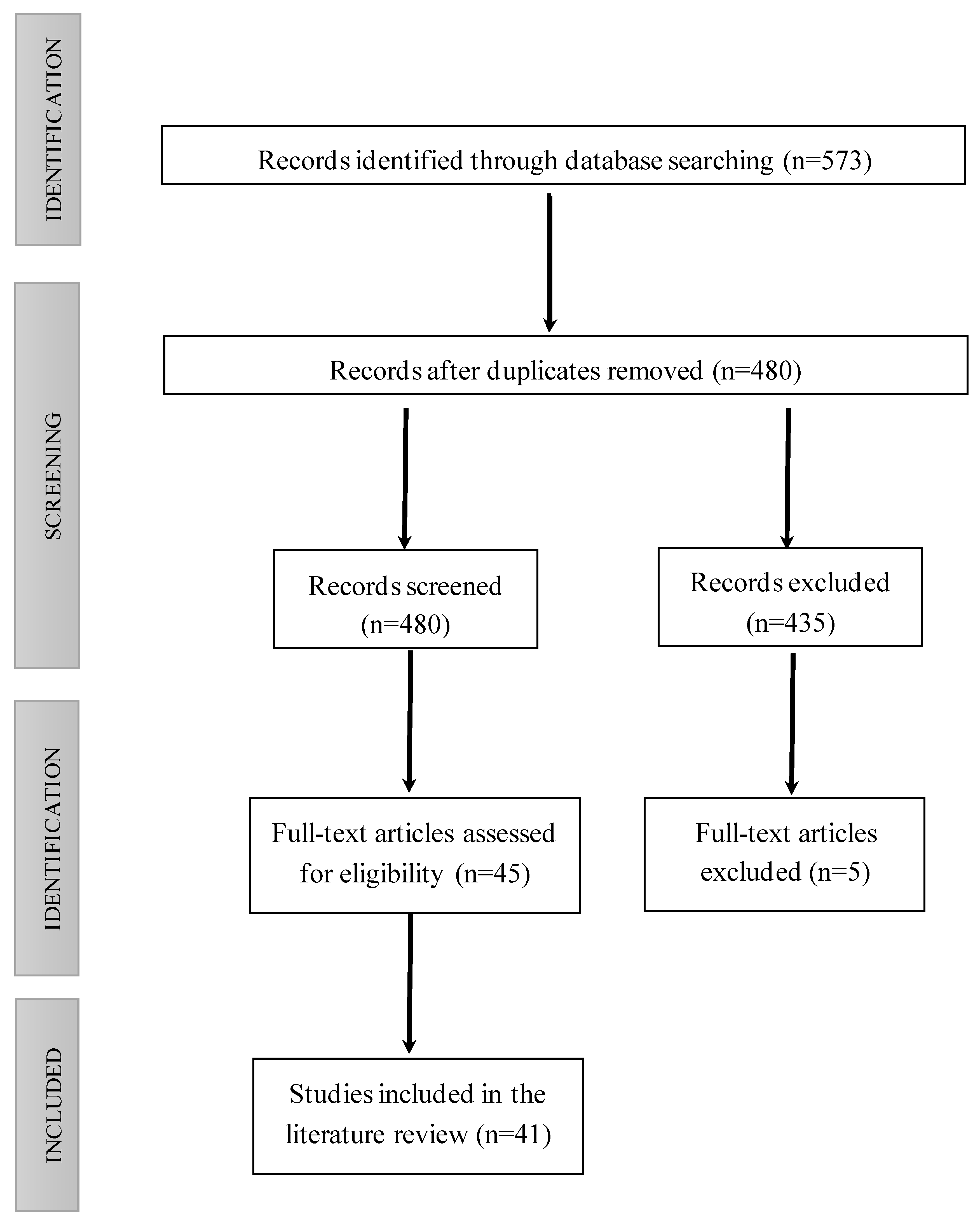
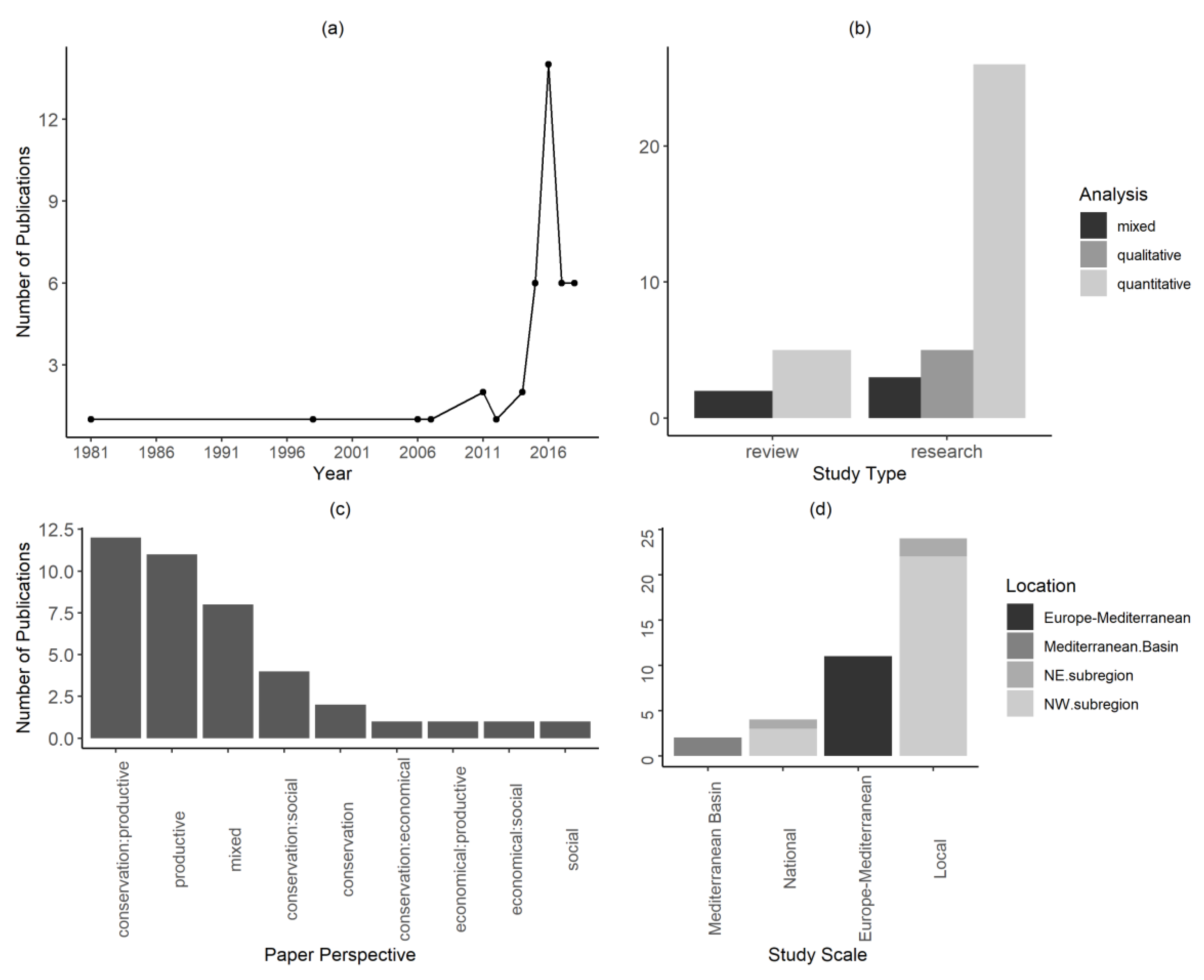
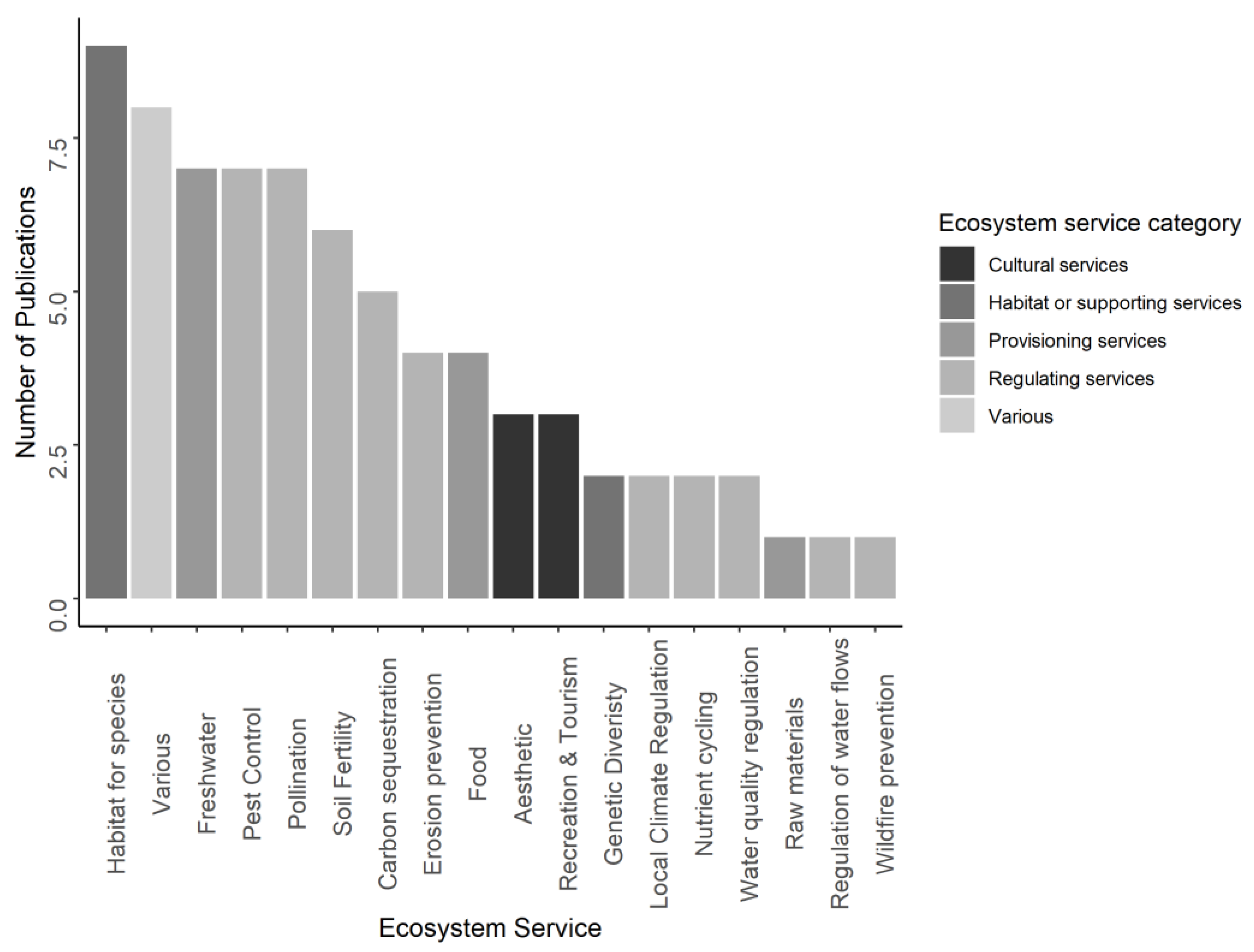
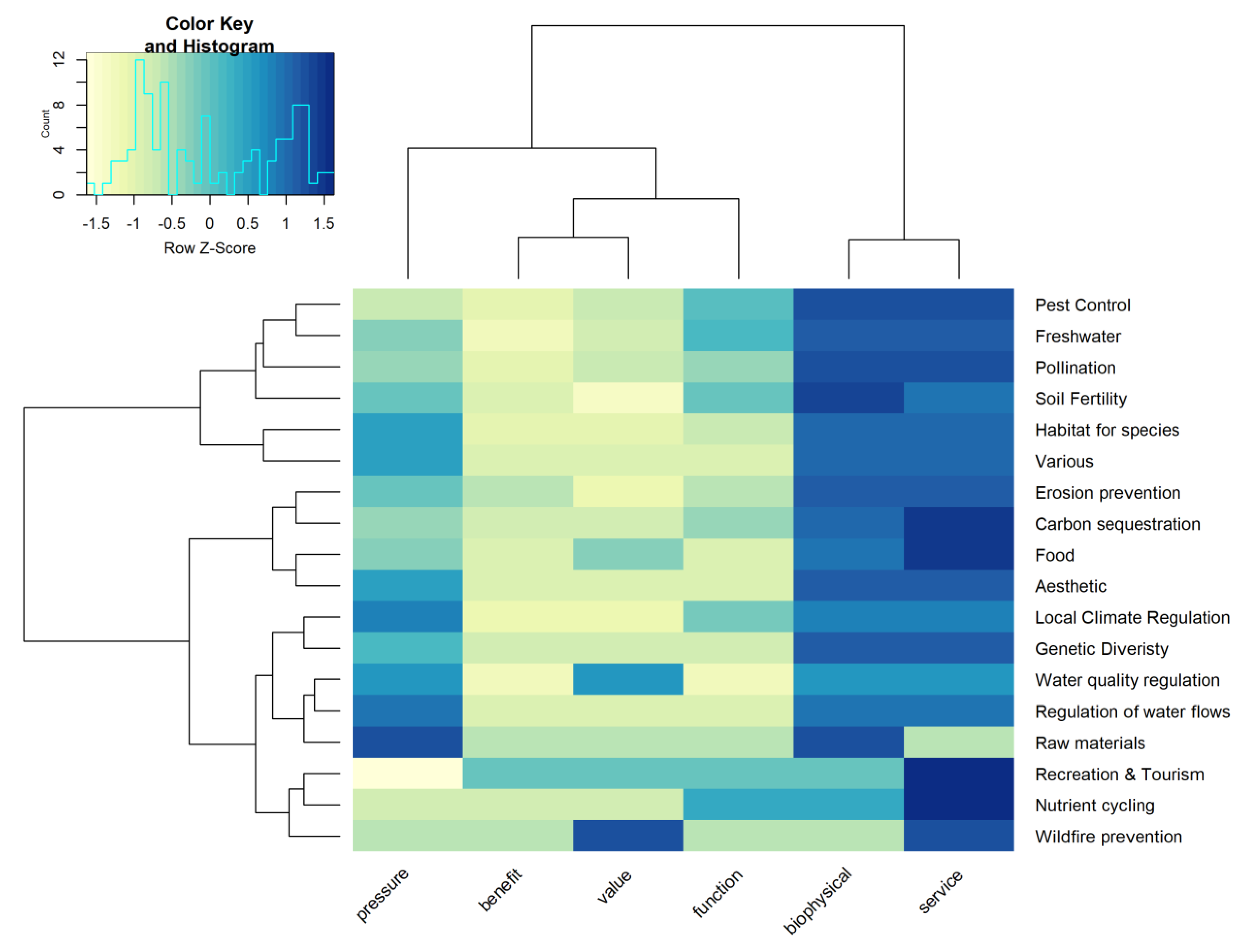
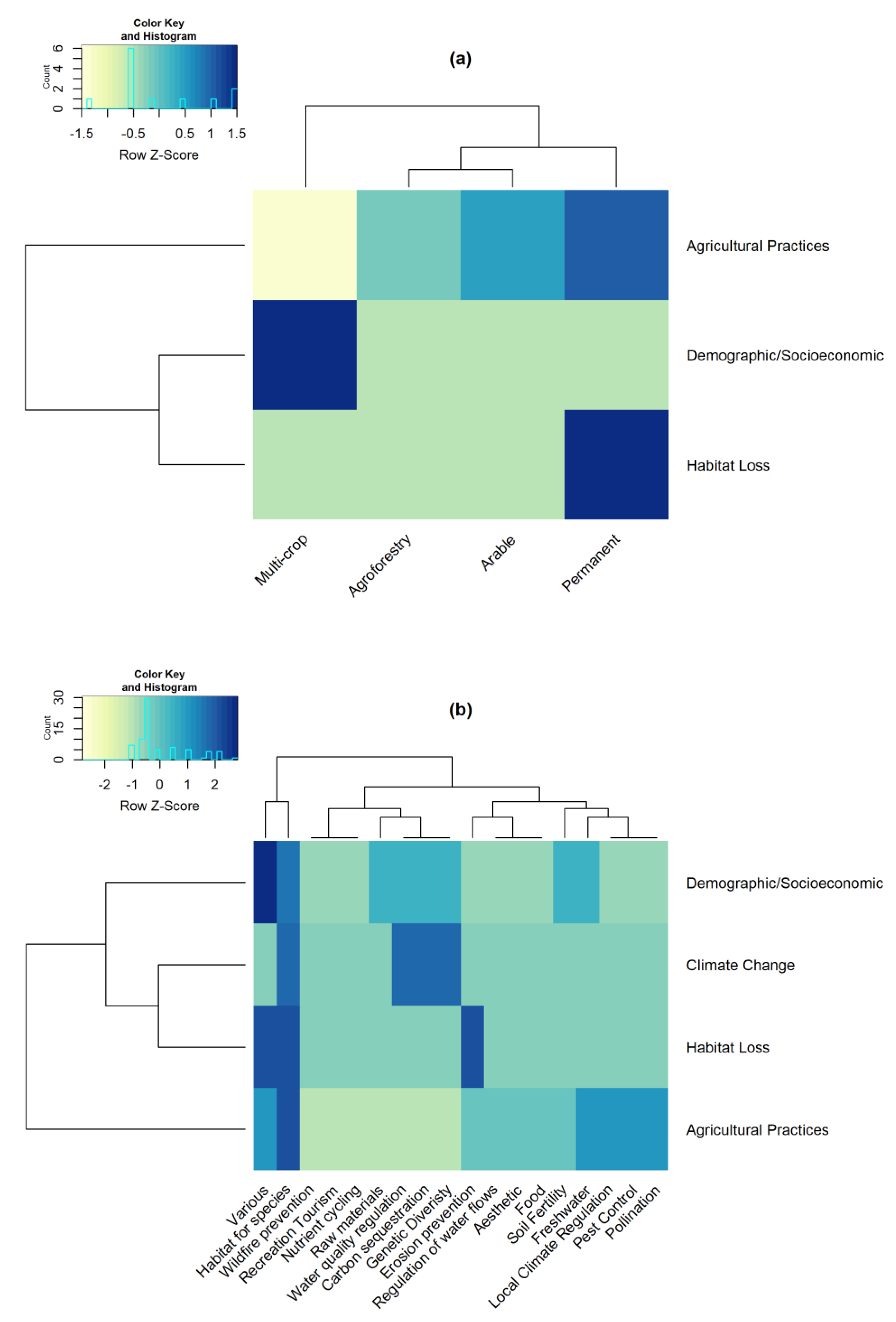
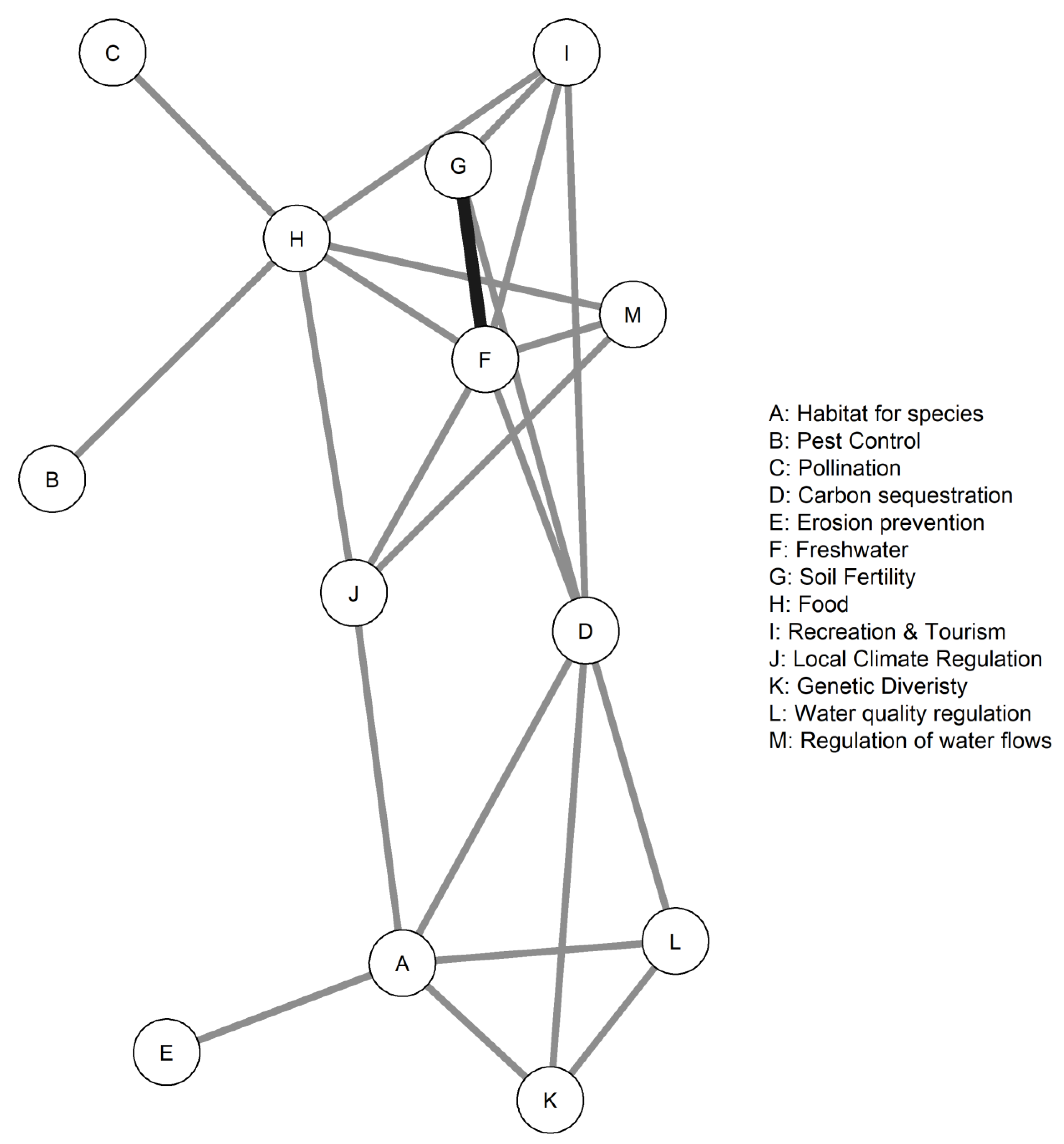
| Ecosystem Service | Number of Ecosystem Service Indicators | |||
|---|---|---|---|---|
| Capacity | Flow | Benefit | Total | |
| Food provision | 6 | 3 | 1 | 10 |
| Raw material | 2 | 1 | 0 | 3 |
| Fresh water | 3 | 2 | 0 | 5 |
| Wastewater treatment | 1 | 1 | 1 | 3 |
| Pollination | 9 | 2 | 1 | 12 |
| Erosion prevention and maintenance of soil fertility | 27 | 6 | 0 | 33 |
| Habitat for species | 7 | 0 | 5 | 12 |
| Carbon sequestration and storage | 3 | 0 | 1 | 4 |
| Biological control | 12 | 0 | 0 | 12 |
| Maintenance of genetic diversity | 1 | 0 | 0 | 1 |
| Local climate and air quality | 0 | 1 | 0 | 1 |
| Moderation of extreme events | 1 | 0 | 0 | 1 |
| Aesthetic appreciation and culture | 11 | 1 | 1 | 13 |
| Total: | 83 | 17 | 10 | 110 |
© 2020 by the authors. Licensee MDPI, Basel, Switzerland. This article is an open access article distributed under the terms and conditions of the Creative Commons Attribution (CC BY) license (http://creativecommons.org/licenses/by/4.0/).
Share and Cite
Balzan, M.V.; Sadula, R.; Scalvenzi, L. Assessing Ecosystem Services Supplied by Agroecosystems in Mediterranean Europe: A Literature Review. Land 2020, 9, 245. https://doi.org/10.3390/land9080245
Balzan MV, Sadula R, Scalvenzi L. Assessing Ecosystem Services Supplied by Agroecosystems in Mediterranean Europe: A Literature Review. Land. 2020; 9(8):245. https://doi.org/10.3390/land9080245
Chicago/Turabian StyleBalzan, Mario V., Renata Sadula, and Laura Scalvenzi. 2020. "Assessing Ecosystem Services Supplied by Agroecosystems in Mediterranean Europe: A Literature Review" Land 9, no. 8: 245. https://doi.org/10.3390/land9080245
APA StyleBalzan, M. V., Sadula, R., & Scalvenzi, L. (2020). Assessing Ecosystem Services Supplied by Agroecosystems in Mediterranean Europe: A Literature Review. Land, 9(8), 245. https://doi.org/10.3390/land9080245






